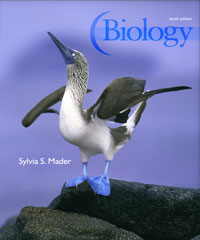Biology (Mader), 10th EditionChapter 10:
Meiosis and Sexual ReproductionLearning OutcomesAfter studying this chapter, you should be able to accomplish the following outcomes. Halving the Chromosome Number
- Contrast haploid and diploid chromosome numbers.
- Explain what is meant by homologous chromosomes.
Genetic Variation
- Describe the role of crossing-over in contributing to genetic variation.
- Define independent assortment and describe how it contributes to genetic variation in the offspring.
The Phases of Meiosis
- List the phases of meiosis, discussing the major events that occur during each phase.
- Describe how interkinesis differs from interphase.
Meiosis Compared to Mitosis
- Compare and contrast the end products of meiosis to that of mitosis, addressing the number of daughter cells produced, the number of divisions, the number of chromosomes in the daughter cells, and whether or not the daughter cells are genetically identical to each other and/or to the parent cell.
- List the events that occur during prophase I that do not occur during prophase of mitosis.
- Discuss the difference in chromosome alignment during meiosis I with that of mitosis.
The Human Life Cycle
- Contrast the life cycle of plants with the life cycle of animals.
- Describe spermatogenesis and oogenesis in humans.
Changes in Chromosome Number and Structure
- Define aneuploidy, and contrast monosomy with trisomy.
- Explain how nondisjunction may cause aneuploidy.
- List the known changes in number of sex chromosomes in humans, and briefly describe the symptoms of each.
- Describe the four types of changes in chromosome structure that may occur.
- List some human syndromes that are associated with changes in chromosome structure.
 | 




